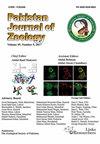尿素处理甘蔗渣对草鱼生长、近似组成、微生物区系及消化酶活性的影响
IF 0.5
4区 生物学
Q4 ZOOLOGY
引用次数: 0
摘要
本试验旨在研究尿素处理甘蔗渣对草鱼生长、肠道菌群和消化酶的影响。试验日粮中尿素含量分别为0% (CTRL)、0.7% (T1)、1.4% (T2)和2.1% (T3),饲喂湿重为3%的试验饲料,每组设2个重复槽。饲喂2.1%尿素处理的甘蔗渣(T3)的鱼的生长显著高于(P<0.05) T2、T1和CTRL。T3组的饲料系数和特定生长率也显著高于T2、T1和CTRL组。鱼类近似分析表明,T2组鱼的粗蛋白质水平显著高于其他各组,T1组鱼的粗脂肪水平显著高于其他各组,其次是T2、CTRL和T3组。与T3、T1和CTRL组相比,T3组干物质含量显著高于T2组,T2组灰分含量显著高于对照组。T2组的淀粉酶和脂肪酶浓度显著高于T3、T1和CTRL组。T3组的蛋白酶浓度显著高于对照组,其次是T1、T2和CTRL组。最后,在T1、T2和T3鱼组中证实了发酵乳杆菌的存在。综上所述,经尿素处理的甘蔗渣可作为idella的饲料原料,对鱼类的营养价值无不良影响。本文章由计算机程序翻译,如有差异,请以英文原文为准。
Effect of Urea Treated Sugarcane Bagasse on Growth, Proximate Composition, Microbial Flora and Digestive Enzymes Activities of Grass Carp (Ctenopharyngodon idella)
A 90 days experimental trial was conducted to evaluate the effect of urea treated sugarcane bagasse on the growth, gut microflora and digestive enzymes of grass carp ( Ctenopharyngodon idella ). Fish were fed to 3% wet body weight per day with experimental diets having 0% (CTRL), 0.7% (T1), 1.4% (T2) and 2.1% (T3) urea, with each group having two replicate tanks. Fish fed on 2.1% urea treated sugarcane bagasse (T3) showed significantly (P<0.05) higher growth as compared to T2, T1 and CTRL. The feed conversion ratio and specific growth rate were also significantly higher in T3 fish group, followed by the T2, T1 and CTRL groups. Proximate analysis of fish showed that the level of crude protein was higher significantly in T2 fish than other groups and crude fat level was significantly higher in T1 fish, followed the T2, CTRL and T3 fish groups. The percentage level of dry matter was significantly higher in T3 fish and ash percentage was significantly higher in T2 fish relative to T3, T1 and CTRL groups. Amylase and Lipase concentration was significantly higher in T2 fish compared with T3, T1 and CTRL groups. Protease concentration was significantly higher in T3 fish, followed by the T1, T2 and CTRL fish groups. Lastly, the presence of Lactobacillus fermentum was confirmed in the T1, T2 and T3 fish groups. Overall, the results showed that urea treated sugarcane bagasse can be used as a feed ingredient for C. idella and has no adverse effect on the nutritional value of fish.
求助全文
通过发布文献求助,成功后即可免费获取论文全文。
去求助
来源期刊

Pakistan Journal of Zoology
生物-动物学
CiteScore
1.10
自引率
16.70%
发文量
306
审稿时长
4.5 months
期刊介绍:
Pakistan Journal of Zoology (Pakistan J. Zool.) publishes original articles in English on all aspects of animal life. Generally these articles will be in, or related to one of the following subject areas: Physiology, Cell Biology, Molecular Biology, Genetics, Bioinformatics, Toxicology, Forensic Science, Developmental Biology, Entomology, Parasitology, Microbiology, Biotechnology, Pathology, Palaeontology. Taxonomy, Environmental Biology, Wildlife, Fisheries, Vertebrate and Invertebrate Morphology. Additionally, the journal considers research on health and clinical studies. Short communications are regularly considered, however, uninvited review articles, first records/reports of known species, case reports/studies and survey reports are not published in Pakistan Journal of Zoology.
 求助内容:
求助内容: 应助结果提醒方式:
应助结果提醒方式:


